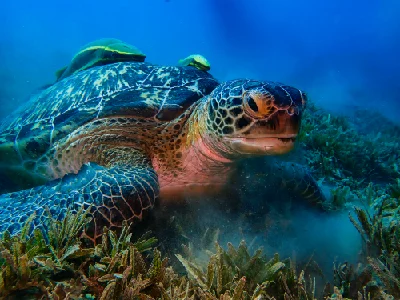Green Sea Turtle
Chelonia mydas
The green sea turtle, or Chelonia mydas, is a large marine reptile found in tropical and subtropical oceans worldwide. These turtles are notable for their size, reaching up to 1.5 meters (5 feet) in length, and weighing between 68-190 kg (150-419 lbs), with some individuals even heavier. Their name is derived from the green fat beneath their carapace, which can range in color from olive to almost black, particularly among certain Pacific populations.
Green sea turtles inhabit a wide variety of marine environments, including tropical waters, coastal areas, bays, and lagoons abundant with seagrass and algae. They are excellent swimmers, thanks to their streamlined bodies and flipper-like limbs, usually moving at speeds around 2.5-3 km/h (1.6-1.9 mph). As juveniles, they tend to be carnivorous, eating fish, eggs, and marine invertebrates. However, as they mature, their diet shifts predominantly to seagrasses and algae, playing a role in maintaining the health of seagrass beds by trimming blades rather than uprooting them.
These turtles typically nest on sandy beaches, where females lay eggs every 2 or 3 years. Each nest can contain 100 to 150 eggs, which incubate for approximately 45-60 days. Temperature plays a crucial role in determining the sex of the hatchlings—warmer sands generally produce females, while cooler sands produce males. Once hatched, the young turtles make a perilous journey to the ocean, facing numerous predators along the way.
Green sea turtles can live up to 90 years in the wild if they avoid predators like tiger sharks, especially near nesting sites. Unfortunately, human activities, such as habitat destruction, pollution, and illegal hunting, threaten their survival. They are classified as endangered and are protected under international law. Conservation efforts focus on protecting their nesting sites and reducing threats from human activities.
In terms of behavior, adult green sea turtles are mostly solitary and migrate long distances between feeding grounds and nesting beaches. Their reproductive system involves scramble polygamy, where males actively compete for females. Males typically have longer tails and recurved claws on their flippers to aid in mating.
Overall, green sea turtles are a critical part of marine ecosystems, contributing to the health of seagrass beds and coastal habitats while serving as indicators of ocean health. Efforts to preserve their populations are essential for both ecological balance and biodiversity.
Comments
Please, sign in to leave comment
No Comments yet
Last Update: May 28, 2025

